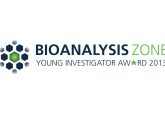2014 Young Investigator: Joe M El-Khoury

Nominee:
Nominated By:
Supporting Comments:
What made you choose a career in bioanalysis?
During my years as an undergraduate researcher at AUB (Lebanon), I was especially fascinated by the modern techniques of bioanalytical chemistry and their applications to the field of medicine, and it was my strongest desire to be able to translate this knowledge in a way that would benefit patients through improved medical care and clinical research. Hence, I traveled 6000 miles to pursue graduate studies in Clinical-Bioanalytical Chemistry at Cleveland State University and Cleveland Clinic (USA). Ever since, it has been my goal to develop new methods and investigate new biomarkers with LC–MS/MS.
Describe the main highlights of your bioanalytical research, and its importance to the bioanalytical community.
Glomerular filtration rate (GFR) is the best overall index of kidney function. It can be accurately measured by quantifying the amount of an exogenous marker (typically radioactive) in serum and urine, or estimated (eGFR) using equations that include the measurement of serum creatinine. We developed a LC–MS/MS method to measure non-radioactive iothalamate in serum and urine that eliminates unnecessary exposure of patients and personnel to radioactive material when assessment of GFR is required. The method is simple and ultrafast (2.1 min) and showed excellent correlation with the original radioactive method in a clinical study. On the other hand, serum creatinine is an imperfect marker of GFR with many known limitations. Symmetric dimethylarginine (SDMA) is an emerging marker for kidney function. We developed a LC–MS/MS for the measurement of SDMA and fully characterized the assay with establishment of its reference intervals in 51 healthy adults. The assay was recently used to examine the correlations between SDMA, creatinine, and eGFR with measured GFR by iothalamate. SDMA outperformed creatinine and creatinine-based eGFR equations for the determination of GFR. These findings are very promising and provide strong support for the use of SDMA as a marker for kidney function.
Describe the most difficult challenge you have encountered in the laboratory and how you overcame it.
As a PhD student working at Cleveland Clinic, I had to learn how to develop and validate LC–MS/MS assays for the clinical laboratory. These assays are highly complex and require years to master, but the bigger challenge for me was having to learn how to operate LC–MS/MS systems from three different vendors in that time frame on top of applying them clinically for my research projects. This task was daunting but I was fortunate to have had strong support from my method development team. Together we developed a method validation protocol for clinical LC–MS/MS assays to streamline and standardize the process for all assays developed in the lab. In addition, I was trained on the operation of all three vendors’ instruments by attending courses offered by the vendors in addition to being trained on-site by my team. Over the last five years, our LC–MS/MS method development team has published 10 novel LC–MS/MS assays in addition to other non-MS-based assays. Thanks to the team, I was able to accomplish the daunting task of operating these instruments and validating assays for my work. Through this exceptional experience I have learned the value of both LC–MS/MS and teamwork for delivering better patient care.
Where do you see your career in bioanalysis taking you?
It has always been my passion to apply bioanalytical chemistry to patient care. Thanks to the extensive PhD and fellowship training in bioanalytical method development and clinical biochemistry I have received at the Cleveland Clinic, I am very well prepared to lead my own development and discovery team. Effective July 2014, I will be Assistant Professor at Yale University School of Medicine and Assistant Director of the Clinical Chemistry Laboratory at Yale-New Haven Hospital. In my new position, I will be responsible for the development of bioanalytical MS methods with specific applications to clinical endocrinology testing. In addition, I will oversee testing in automation chemistry. It is also my desire to continue investigating new biomarkers for cardiovascular and kidney disease. Of particular interest is our latest data showing higher correlation between symmetric dimethylarginine (SDMA) and actual measurement of GFR than currently used biomarkers, which encourages me to further investigate and clinically validate SDMA as a biomarker for kidney function. It is my hope that I continue to produce methods and clinically validate biomarkers that improve patient lives, wherever my career may take me.
How do you envisage the field of bioanalysis evolving in the future?
In hospitals, the success of recent efforts to reduce volume of blood draws and switch to non-invasive matrices (such as oral fluids) for the measurement of clinically relevant compounds will largely depend on the evolution of bioanalysis. I anticipate that this will be possible largely thanks to LC–MS/MS which offers high sensitivity and specificity and is matrix-independent. This change is already occurring and common examples include the analysis of nicotine and metabolites in oral fluids versus blood. MS has already revolutionized the field of laboratory medicine with applications in microbiology, proteomics and metabolomics and it will continue to drive the discovery of new biomarkers, such as SDMA. However, to unlock its full potential the technology has to become more user-friendly, automatable and less costly so it can become widely available for medical applications and research. In my opinion, this is the major driving force for manufacturers and in-vitro diagnostic companies to improve these technologies, and for bioanalytical laboratories to use them to aid with the discovery of new biomarkers and improve the delivery of patient care.
Please list 5 of your recent publications, and select one that best highlights your career to date in the field of bioanalysis.
1. El-Khoury JM, Bunch DR, Reineks E, Jackson R, Steinle R, Wang S. A simple and fast liquid chromatography tandem mass spectrometry method for measurement of underivatized L-arginine, symmetric dimethylarginine and asymmetric dimethylarginine and establishment of reference ranges. Anal. Bioanal. Chem. 402(2), 771–779 (2012).
2. El-Khoury JM, Bunch DR, Wang S. Is the effect of hemolysis on plasma ammonia measurement overrated? Arch. Pathol. Lab. Med. 136(5), 471–472 (2012).
3. Yuan C, Gabler J, El-Khoury JM, Spatholt R, Wang S. Highly sensitive and selective measurement of underivatized methylmalonic acid in serum and plasma by liquid chromatography-tandem mass spectrometry. Anal. Bioanal. Chem. 404(1), 133–140 (2012).
4. Bunch DR, El-Khoury JM, Gabler J, Wang S. Do deuterium labeled internal standards correct for matrix effects in LC-MS/MS assays? A case study using plasma free metanephrine and normetanephrine. Clinica. Chimica. Acta. 429(2), 4–5 (2014).
5. El-Khoury JM, Bunch DR, Wang S. Radioactive iothalamate versus non-radioactive iothalamate by liquid chromatography-tandem mass spectrometry for the determination of glomerular filtration rate. Clinical Chemistry Abstract Supplement, Clin. Chem. 58(S10), A114 (2012).
First choice: El-Khoury JM, Bunch DR, Reineks E, Jackson R, Steinle R, Wang S. A simple and fast liquid chromatography tandem mass spectrometry method for measurement of underivatized L-arginine, symmetric dimethylarginine and asymmetric dimethylarginine and establishment of reference ranges. Anal. Bioanal. Chem. 402(2), 771–779 (2012).
Reasoning: The LC–MS/MS method developed in the choice above is simple and fast and was very well characterized to allow clinical validation of dimethylarginines. This method is currently being used to validate SDMA as a biomarker for kidney function in a large clinical study.




